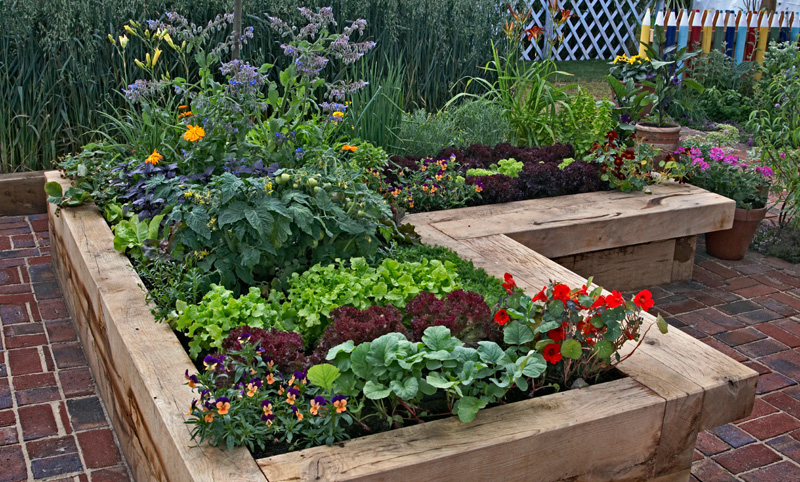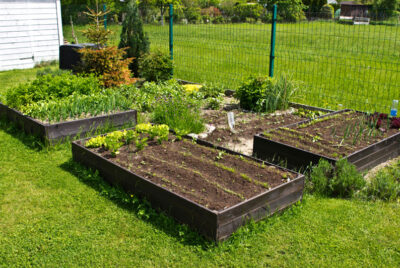The Joy of Raised Garden Beds
What Are Raised Garden Beds?
A raised garden bed, often referred to as a garden box or planter box, is an isolated garden area that is built above the natural terrain. Typically constructed from wood, metal, or stone, these elevated platforms are filled with soil and compost, providing an exclusive environment for growing a variety of plants—from vegetables and herbs to flowers and shrubs. The distinct separation from the ground soil allows for better control over the soil quality and improves the overall health of the plants.
Benefits of a Raised Garden Bed
The advantages of raised garden beds extend beyond just aesthetic appeal. Firstly, they allow for better soil management. Since the soil in a raised bed is not compacted by foot traffic, it remains loose and well-aerated, promoting healthier root growth and easier plant management. Another significant benefit is the reduction of strain on the gardener’s back and knees because the beds can be built to a comfortable height. This makes planting, weeding, and harvesting easier and more accessible for everyone, regardless of mobility issues.
Moreover, raised beds warm up earlier in the spring and stay warm longer into the fall. This extended growing season allows gardeners to plant earlier and harvest later, increasing the productivity of the garden. Pest management is also simplified in raised beds; the elevated design and clear boundaries help deter some ground pests, and the addition of hardware cloth or similar materials can prevent burrowing creatures from entering the bed.
Watering is more efficient in raised beds as well, as you can target the water directly to the plant roots, minimizing waste and reducing the watering needs. Additionally, raised beds can help prevent soil erosion, protect your plants from invasive seeds, and can be designed to fit into various landscapes, making them a versatile option for urban and suburban gardens alike.
Planning Your Raised Garden Bed
Choosing the Right Location
Choosing an optimal location is crucial for the success of your raised garden bed. The ideal spot will receive at least six to eight hours of sunlight per day, which is vital for most vegetables and flowers. Avoid areas that are too shaded by trees or structures. Consider the proximity to a water source as this will greatly simplify the watering process. It’s also wise to think about the proximity to your tool storage to save time and effort in transporting gardening equipment.
Determining the Best Size and Height
The dimensions of your raised bed can greatly influence its functionality. A width of four to six feet is ideal as it allows easy reach to the center from either side without the need to step into the bed, preserving soil structure and preventing compaction. The height should be tailored to your physical comfort; typically, heights of one to two feet are beneficial for reducing back strain. For gardeners using wheelchairs, a height of 24 to 30 inches can provide excellent accessibility.
Selecting Materials for Your Raised Garden Bed
When it comes to materials, durability and safety are paramount. Woods like cedar and redwood are popular choices due to their resistance to rot and pests. However, if budget constraints are an issue, treated lumber is an option, but make sure it is safe for use in gardens and will not leach harmful chemicals into the soil. Alternative materials include bricks, concrete blocks, or even recycled plastics. Each material has its aesthetic and practical benefits, so choose one that best fits your garden’s style and your environmental conditions.
Advanced Customizable Features for Enthusiasts
For those who wish to enhance their gardening experience further, consider incorporating built-in irrigation systems such as drip lines or soaker hoses to ensure consistent soil moisture. Trellises can be added to support climbing plants like cucumbers and peas, which can help maximize the use of vertical space in the garden. Adding a greenhouse cover or a cold frame atop the raised bed can extend the growing season by protecting plants from early frosts and overly chilly conditions.
Building Your Raised Garden Bed
Tools and Materials Needed
To build a basic raised garden bed, you will need tools such as a circular saw or hand saw, a drill with screws, a tape measure, a level, a hammer, and safety equipment like gloves and goggles. For materials, aside from your choice of wood or other framing materials, you’ll need soil, possibly landscaping fabric, and any additional amendments like compost or perlite to improve soil quality.
Step -by-Step Building Guide
Begin by measuring and cutting your materials to size, according to the dimensions you’ve chosen for your bed. Assemble the frame on a flat surface to ensure it is square and level before placing it in its designated spot. If using wood, pre-drilling holes can prevent the wood from splitting when you insert screws. Once the frame is assembled, place it in the chosen location, and if necessary, level the area to avoid water pooling. Line the bottom of the bed with landscape fabric to prevent weeds from growing up through the soil and fill the bed with your soil mix. Pack the soil lightly to remove air pockets but avoid over-compacting, which could hinder root growth.
Tips for Durable Construction
To ensure longevity, choose materials that are resistant to decay. For wood constructions, consider applying a natural preservative like linseed oil to extend its life. Ensure all metal components are rust-proofed, especially in wet climates. To further protect the wood and keep the soil healthy, line the inside walls of your wood beds with a plastic sheeting, which will act as a barrier between the moist soil and the wood. Always ensure good drainage by incorporating a few inches of gravel at the base of your bed, covered by a layer of sand before adding your soil. This helps prevent water from pooling at the root level, which could be detrimental to plant health.
Best Soil and Compost Mixtures
Soil Considerations for Raised Beds
The choice of soil is a critical factor in the success of your raised garden bed. Ideal soil for raised beds is loose, fertile, and well-draining. A common recommendation is to use a mix of one-third peat moss, one-third vermiculite, and one-third compost. This blend provides a balanced medium that retains moisture while still allowing excess water to drain away, preventing root diseases.
Creating the Perfect Compost Mix
To enrich the soil in your raised bed, you can create your own compost mix at home. Start with equal parts brown and green materials. Brown materials include dried leaves, twigs, and cardboard, which provide carbon. Green materials, such as grass clippings, fruit and vegetable scraps, and coffee grounds, supply nitrogen. Turn your compost pile every few weeks to aerate it, which speeds up the decomposition process. Over time, this homemade compost will transform into a rich, organic material that is perfect for your garden bed, offering a sustainable source of nutrients for your plants.
Planting in Raised Garden Beds
Best Plants for Raised Beds
Raised beds are ideal for a variety of plants. Vegetables like tomatoes, carrots, and leafy greens thrive in the well-drained soil conditions these beds provide. Herbs such as basil, thyme, and cilantro also do well, as they can benefit from the controlled soil environment. For floral beauty, consider marigolds, zinnias, and sunflowers, which can add color and attract pollinators to your garden.
Planting Techniques to Maximize Yield
To maximize the yield of your raised bed, consider using square foot gardening techniques, which divide the bed into small square sections, each dedicated to a single type of plant. This method maximizes space use and helps in managing crop rotation. Vertical planting can also be employed to make full use of the space. Use trellises and planting stakes to support climbing plants and vines, which allows for more ground space to plant other crops.
Maintaining Your Raised Garden Bed
Regular Maintenance Tips
Regular maintenance is key to a thriving garden bed. Keep the soil moist but not waterlogged. Mulching with organic materials such as straw or shredded leaves can help retain moisture, suppress weeds, and add nutrients back into the soil as they decompose. Periodic checking and replacing of the mulch layer is necessary to maintain its benefits.
Seasonal Adjustments and Care
Adjust your planting and maintenance practices with the changing seasons. In the spring, prepare your bed by clearing out any debris from the previous season and replenishing the soil with fresh compost. During hot summers, ensure that your plants receive enough water, especially during dry spells. In the fall, plant cover crops such as clover or rye to enrich the soil and prevent erosion over the winter months. When winter approaches, protect perennials by mulching heavily around the base.
Overcoming Common Challenges
Dealing with Pests and Diseases
Effective management of pests and diseases is crucial. Use crop rotation to prevent diseases from taking hold. Introduce beneficial insects, like ladybugs and lacewings, which prey on harmful pests such as aphids and mites. For larger pests, such as rabbits and deer, physical barriers like fencing or netting may be necessary.
Addressing Drainage Issues
To mitigate drainage issues, ensure that your soil mixture is well-draining as mentioned earlier. If waterlogging is observed, consider adding more coarse sand or perlite to improve the soil texture. Additionally, regularly check and clear the drainage pathways within and around your garden bed to prevent blockages that could lead to stagnant water.
Enhancing Your Garden’s Aesthetics
Decorative Ideas for Raised Garden Beds
Raised garden beds offer not only functional benefits but also aesthetic enhancements to any garden space. Consider painting or staining the wood of your raised beds to match or complement your outdoor decor. Use patterns or thematic designs to create visual interest. Another option is to incorporate sculptural elements like decorative corner posts or use different materials for each level of a tiered bed, which adds a dynamic visual element to the garden.
Incorporating Pathways and Accessories
Pathways are essential for accessibility and circulation throughout your garden. They can be made from gravel, bark mulch, or stepping stones and should be wide enough to comfortably navigate through the garden, even with a wheelbarrow. Adding accessories such as garden benches, water features, or a birdbath can create a more inviting and relaxing garden atmosphere. Consider placing these strategically to draw the eye and provide convenient resting spots.
Start Your Own Raised Garden Bed!
It’s time to embark on your own raised bed gardening journey! Enjoy the transformation that raised beds can bring to your gardening experience— turn underused or unsuitable spaces into productive and beautiful garden plots. You too, regardless of skill level or gardening space, can achieve success with a raised garden bed.


